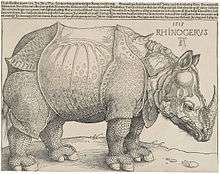1515 in science
The year 1515 in science and technology included many events, some of which are listed here.
| |||
|---|---|---|---|
|
Astronomy
- A year in which Earth's so-called "second moon" Cruithne (discovered in 1986) makes a closest approach to earth. The two are in 1:1 orbital resonance. This next happens about 1903; the following occasion will be in July 2292.
Zoology
- May 15 – An Indian rhinoceros arrives in Lisbon, the first to be seen in Europe since Roman times.[2]
Births
- February 18 – Valerius Cordus, German physician and botanist (died 1544)
- Cristóbal Acosta, Portuguese physician and natural historian (died 1594)
- Giorgio Biandrata, Italian court physician (died 1588)
- Petrus Ramus, French logician (k. 1572)
- Johann Weyer, Dutch physician and occultist (died 1588)
- approx. date – Leonard Digges, English mathematician and surveyor (d. c.1559)
Deaths
- Alonso de Ojeda, Spanish navigator (born c.1466)
- Andreas Stoberl, Austrian astronomer, mathematician and theologian (born 1465)
gollark: I'm sure you'd like to think so.
gollark: I don't think it actually ships asynchronous mutexoids at all? This is actually a problem. Hmmm.
gollark: Oh, and they actually ship async synchronization primitives.
gollark: Yes, but they're complex.
gollark: Unlike Nim's, they have to manage accursed lifetime apiology, and actually have threadpools and good schedulers.
References
- Van Duzer, Chet (2010). Johann Schöner’s Globe of 1515: Transcription and Study. Philadelphia, PA: American Philosophical Society. ISBN 978-1-60618-005-1.
- Bedini, Silvano A. (1997). The Pope's Elephant. Manchester: Carcanet Press. ISBN 1-85754-277-0.
This article is issued from Wikipedia. The text is licensed under Creative Commons - Attribution - Sharealike. Additional terms may apply for the media files.
